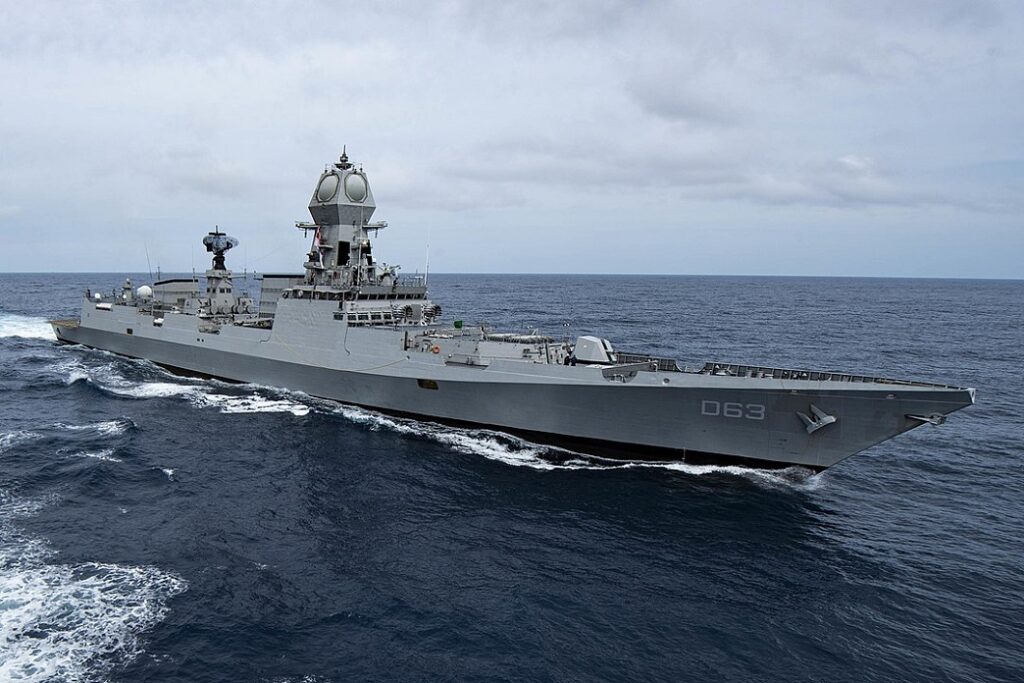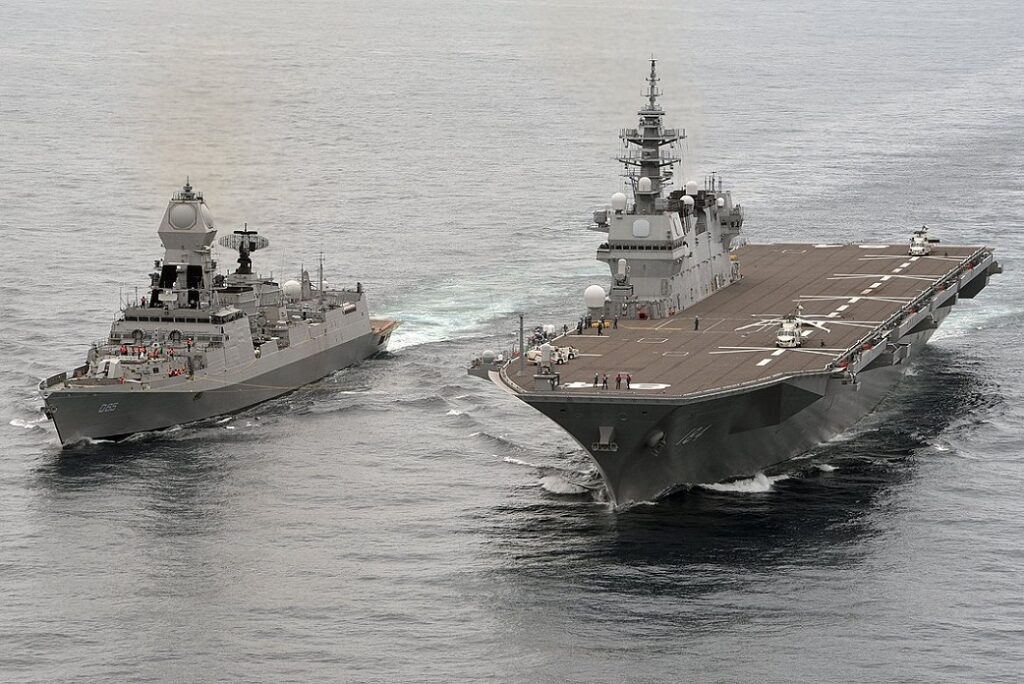SeaEagle
FULL MEMBER
New Recruit
- Joined
- Jun 23, 2021
- Messages
- 49
- Reaction score
- 0
- Country
- Location

INS Kolkata steams in the North Arabian Sea during Malabar 2020. (US Navy photo)
The Kolkata-class and Visakhapatnam-class destroyers are the Indian Navy’s most proficient surface combatants today. Therefore, they will retain these designations until the Project 18-class destroyers are launched in 2028.
History and Background
In 1980, India began an indigenous destroyer design and construction program. The first vessel in this series, INS Delhi, was put down in 1987 and launched in 1991. However, due to the Soviet Union’s disintegration, the armament systems for the Delhi-class, also known as the Project 15-class, we’re unable to be delivered on time. As a result, the program was delayed by three years. Finally, the Indian Navy could commission INS Delhi in 1997.
In 1986, India launched the Kolkata-class destroyer program as a replacement for the Delhi-class destroyers. Initially, the program’s objective was to design and build a surface combatant capable of superior air defense, ground attack, anti-submarine warfare, and anti-ship warfare to its predecessor. However, the Indian Navy later requested a new destroyer based on the Delhi class with advanced technology subsystems and a stealth design. Thus, in 2000, India authorized the construction of a new kind of warship dubbed the Kolkata-class.

Ins Kolkata Steams During Malabar 2020. Malabar 2020 (U.S. Navy Photo)
The Kolkata-Class
The Kolkata class, also known as the Project 15A-class, has similar dimensions to the Delhi class. But, there are nearly 2,500 modifications to its design than its predecessor’s. Similar to previous naval shipbuilding programs, India also experienced unfortunate problems and delays in the Kolkata class. Russia could not deliver naval-grade steel on time. While the design works continued, the Indian Navy decided to change the ship’s surface-to-air missile system and gun. Also, it demanded the inclusion of a sonar dome and modification of the helicopter hangar. Naturally, these changes caused delays.
In 2003, Mazagon Dock Limited lay down INS Kolkata, the first ship of this type. However, the difficulties were not resolved. The Ukrainian supplier was unable to supply the ship’s propellers and shafts. As a result, India had to place a new order with Russia for propellers and shafts in 2006. In the same year, INS Kolkata was launched. However, some issues arose during the sea trials. For instance, working the engine, gearbox, and shaft concurrently resulted in increased noise. Additionally, a malfunctioning carbon dioxide valve resulted in a tragic accident in 2014. Each issue is addressed individually, and the Indian Navy commissioned the INS Kolkata in 2014.
Three ships of this class are among the region’s most capable surface combatants, and they represent a watershed moment in India’s shipbuilding technology.
The Visakhapatnam-Class
Visakhapatnam-class aircraft, also known as Project 15B-class aircraft, is a more capable variant of the Kolkata class. In 2011, India authorized the construction of the Visakhapatnam-class. Its hull is identical to that of the Kolkata class. However, significant alterations have occurred in the superstructure. For instance, the Visakhapatnam-class is more stealthy than its forerunner. The bridge and tower have been rebuilt to lower the radar cross-section. Additionally, it features a flush deck and enhanced acoustic and infrared signature reduction technologies. The Visakhapatnam-class helicopter is secured through a rail-less helicopter traversing system.

Launching Of The Future Ins Visakhapatnam
It is network-centric in design and includes a ship data network, an autonomous power management system, and a combat management system. This feature enables the complement to be reduced while enhancing fighting efficiency. In 2013, India lay down the first of four ships in its class, the INS Visakhapatnam. Two years later, she was launched. This year, the Indian Navy intends to commission the destroyer.
General Features of Kolkata-Class
The Kolkata class has a total enrollment of 390 crew. It has a 7,400-ton displacement. The destroyer measures 163.2 meters in length, 17.4 meters in beam, and 6.5 meters in draught. Four Zorya-Mashproekt DT-59 reversible gas turbines with a combined output of 20,705 horsepower offer a top speed of 30 knots. The ship’s range is 15,000 kilometres at an economical speed of 18 knots. The frigate is armed with two eight-cell vertical launchers for BrahMos anti-ship missiles, four eight-cell vertical launchers for Barak 8 air defence missiles, a 76mm Super Rapido gun, four AK-630 close-in weapon systems, four 533mm torpedo tubes, and two RBU-6000 anti-submarine warfare rocket launchers.
The Kolkata class is equipped with a spacious hangar and flight deck to accommodate two Sea King or Dhruv helicopters. Visakhapatnam-class aircraft is slightly lighter than its predecessors. These ships are capable of network-centric warfare. Due to its cooperative engagement capability, a destroyer of these classes may execute an operation using sensor data from other boats and armament systems. The Indian Navy is the second Navy in the world, after the US Navy, to have achieved the capacity and the first in Asia.

Ins Chennai (D65) With JMSDF JS Kaga During JIMEX 2020.
These classes’ S-band EL/M-2248 MF-STAR radars are capable of surveillance and fire control operations. It can detect, identify, and track fighter jets at a range of 250 kilometres and missiles at a range of 25 kilometres. The radar is capable of monitoring more than 100 targets concurrently. The D-band LW 08 radar can detect a target with a radar cross-section of 2 square meters at a range of 260 kilometres. It is capable of tracking 64 targets concurrently.
General Features of The Visakhapatnam-class
The Visakhapatnam-class ships are armed with the 127mm Mk 45 Mod 5 gun, which ranges 37,000 meters. The EL/M-2248 MF-STAR radar controls the destroyers’ AK-630 close-in weapon systems. Five thousand rounds per minute are the rate of firing of the AK-630. It has an effective range of around 5,000 meters. The anti-submarine warfare rocket launcher RBU-6000 has an effective range of 5,230 meters and a depth capability of 1,000 meters. Typically, salvos of 1, 2, 4, 8, or 12 rockets are launched. Automatic reloading occurs. These ships are armed with 53-65 KE active homing torpedoes with a range of 18,000 meters or SET-65 active-passive homing torpedoes with 20,000 meters. These destroyers are equipped with aviation facilities to accommodate two Sea King or Dhruv helicopters.
Conclusion
China’s ambition today is to control the whole Indian Ocean, beginning with the Malacca Strait. It works to forge alliances with many countries in the region, most notably Pakistan, to accomplish this purpose. As a result, the already tricky Sino-Indian relations have deteriorated further in recent years. A powerful navy is critical for India now more than ever. That increases the value of destroyers of the Kolkata and Visakhapatnam classes. The Kolkata-class destroyers are assigned to the Indian Navy’s Western Naval Command and India’s shipbuilding industry’s pride and joy.
Check out Naval Library App to find out the specifications of the Kolkata-class destroyers.







 ''Derived from earlier Delhi class hulls as well as scaled up from Talwar/Krivak class''? What is that even supposed to mean?
''Derived from earlier Delhi class hulls as well as scaled up from Talwar/Krivak class''? What is that even supposed to mean?